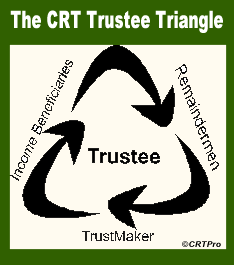CRTPro
The Trustee Triangle
|
For the year 2007,
the IRS reported that 115,754 charitable remainder trusts filed
informational returns. Each trust names a trustee or multiple
trustees. These trustees are broken down into three main categories;
Each
category has its advantages and disadvantages. Banks and
trust companies commonly
have trained trust account executives and a legal review department.
The larger non-profit organizations will normally have a business
office and planned giving officers. Individual trustees are usually
CPAs, attorneys, or self-trustees. Regardless of size
or skill, all have something in common—serving as a CRT
trustee is a very important and, at times, demanding role. The
trustee is positioned right in the center of the CRT triangle.

"The Trustee
is positioned right in the center of the CRT Triangle."
The CRT triangle
illustrates the fact that a charitable trust is a three party
arrangement among (1)the trustmakers, (2)the income beneficiaries,
and (3)the remainder beneficiaries. It is this multi-party
arrangement that causes the CRT to be referred to as a split
interest trust. Each party looks to the trustee to direct the
trust with everyone’s best interests in mind. The trustee
serves as fiduciary and must make difficult decisions about
valuation, investment, administration, and management of the
trust.
"...decisions
must be made with impartiality to each party
in the trustee triangle."
 These
decisions must be made with impartiality to each party in the
trustee triangle. A CRT trustee must always ask itself the following
questions. Are the trust donors happy? Are the income beneficiaries
happy? Are the remainder beneficiaries happy? An effective CRT
trustee will be able to serve all three parties and keep the
trust in compliance with government regulations. These
decisions must be made with impartiality to each party in the
trustee triangle. A CRT trustee must always ask itself the following
questions. Are the trust donors happy? Are the income beneficiaries
happy? Are the remainder beneficiaries happy? An effective CRT
trustee will be able to serve all three parties and keep the
trust in compliance with government regulations.
next
page...The TrustMaker
©CRTPro
2004
|
